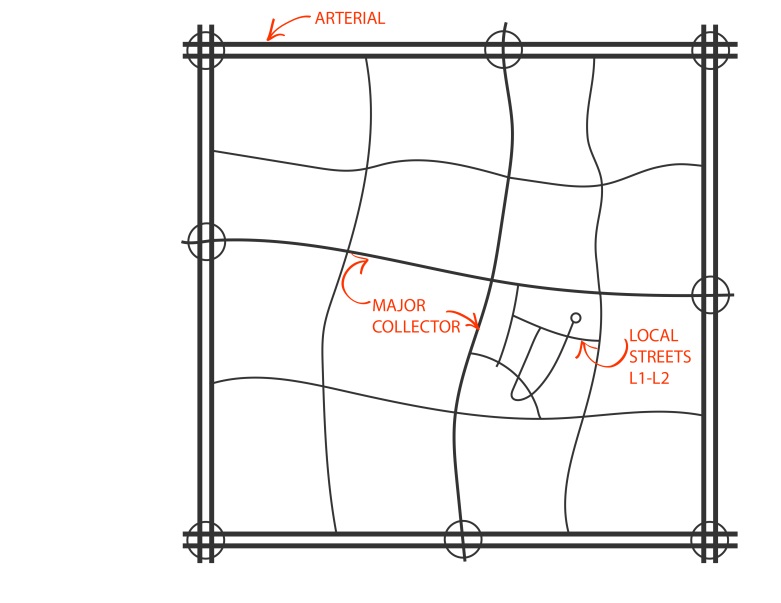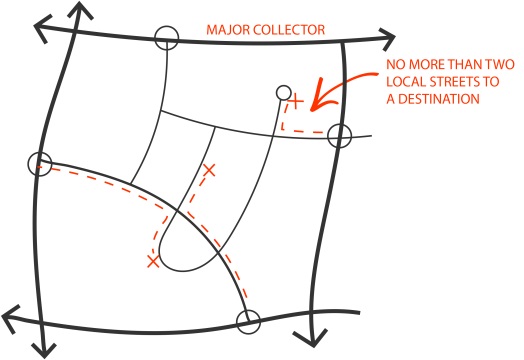4.5.3. ACCESS AND CONNECTIVITY IN SUBDIVISION PLATS AND MASTER PLANS.
New subdivisions and developments for which a Master Plan is required or approved shall meet the following standards to provide through connectivity and mobility and to promote clear and efficient access for emergency vehicles.

Figure 4.5-1: Major Road Connectivity
A. Major Roads.
1. Unless an alternative through-traffic system is described in an approved Master Plan, or the Aurora Transportation Master Plan, each subdivision in Subareas B and C containing one section (640 acres) of contiguous land or more shall reserve or dedicate an arterial street right-of-way along each section line, and shall reserve or dedicate at least one collector street right-of-way to provide a continuous north-south through connection between the east-west section line street alignments, and at least one collector street right-of-way to provide a continuous east-west through connection between the north-south section line street alignments. See Figure 4.5-1.
2. Unless an alternative through-traffic system is described in an approved Master Plan, then in addition to the requirement in Subsection 1 above, each subdivision in Subareas B and C containing one quarter-section (160 acres) of contiguous land or more shall reserve or dedicate at least one collector street right-of-way to provide a continuous north-south through connection between each east-west collector street alignment required by Subsection 1 above, and shall reserve or dedicate at least one collector street right-of-way to provide a continuous east-west through connection between each north-south collector street alignment required by Subsection 1 above. See Figure 4.5-1.
B. Local Destinations.
1. In addition to the requirement of Subsections 1 and 2 above, each subdivision in Subarea B and C shall organize all local streets so that each lot may be accessed by travelling over no more than two (2) local streets after departing from the grid of arterial, collector, and collector streets required by Subsections 1 and 2 above.
2. All street types shall align across major arterials unless the Planning Director and Director of Public Works determine that an alternative alignment will increase pedestrian, bicycle, or automobile safety or reduce traffic congestion. For example, a collector street proposed in a new subdivision shall align across an existing or proposed arterial street with an existing or proposed collector street to form a continuous street network. Stub streets shall match and connect to other streets on the opposite side of the arterial to the maximum extent practicable.

Figure 4.5-2: Wayfinding Connectivity
C. Adjacent Land.
1. Unless the Planning Director and Director of Public Works determine that an alternative alignment will increase pedestrian, bicycle, or automobile safety or reduce traffic congestion, or that topographic or geological conditions make the connection impracticable, where adjacent land has been subdivided with stub streets ending adjacent to a new subdivision, or with a local street ending at a street dividing the new subdivision from the old subdivision, the new subdivision streets shall be designed to align the streets in the adjacent subdivision to allow future through circulation between the two adjacent subdivisions.
2. Where adjacent land has not been platted, subdivisions shall be designed so that at least one local street is constructed as a stub street intended as a future through connection to the adjacent parcel within each one-quarter mile of boundary length.
D. Coordination with Public Transit Providers. Each applicant for a new subdivision shall submit evidence of a written request made to any transit authorities whose service area includes the proposed subdivision, regarding locations for current, new, or future transit stops or connections in or immediately adjacent to the proposed site, and for those mobility hubs shown on the Comprehensive Plan, and shall reflect those stops, connections, and mobility hubs on the subdivision application materials to the maximum extent practicable. (Ord. No. 2019-49 § 1, 08-19-2019)